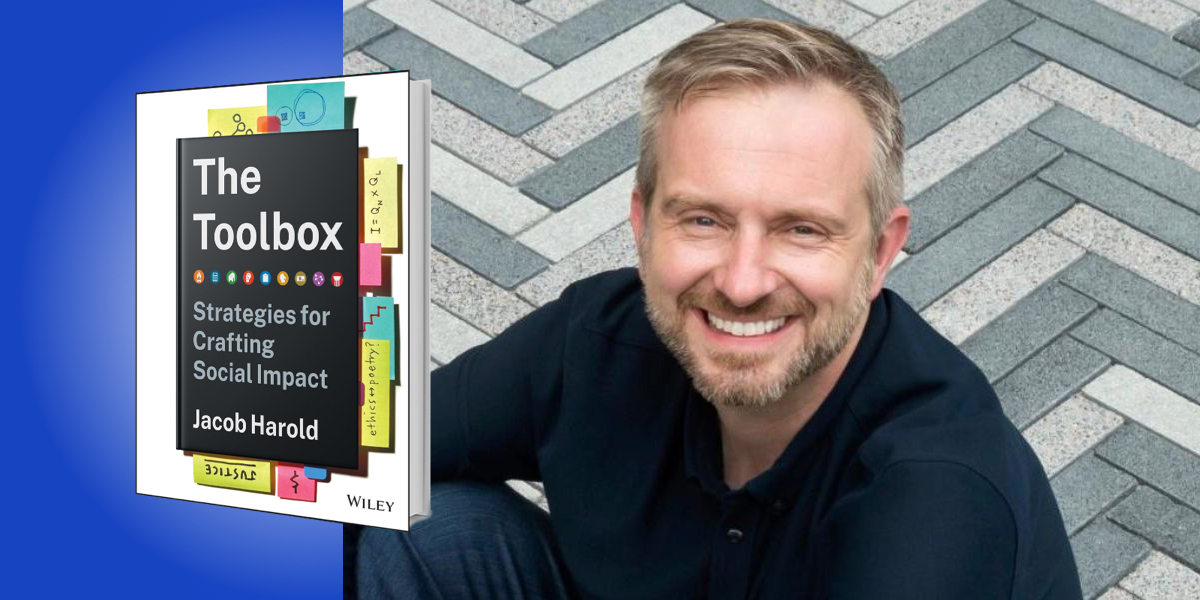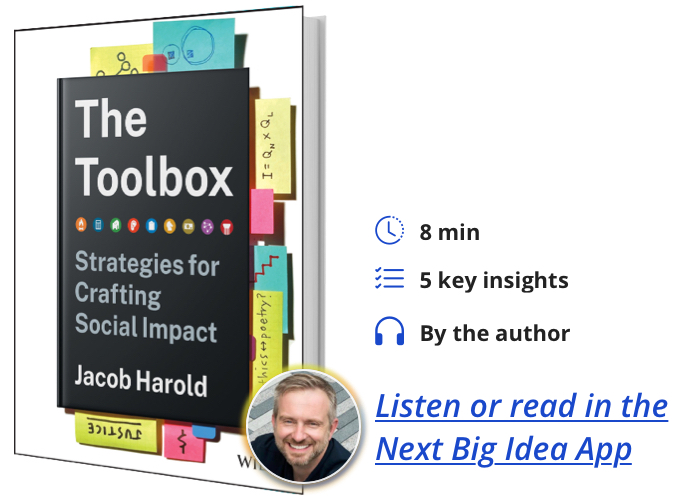Jacob Harold is a social change strategist and executive. He was the CEO of GuideStar, a database of nonprofits, and cofounder of Candid. Throughout the course of his career, he has gained expertise in smart giving and effective nonprofit campaigning.
Below, Jacob shares 5 key insights from his new book, The Toolbox: Strategies for Crafting Social Impact. Listen to the audio version—read by Jacob himself—in the Next Big Idea App.
1. Social change is possible in a chaotic world.
War, pandemic, climate crisis—the challenges of the moment are overwhelming. But history is a story of change. Over the centuries, people have tried building a better world, and they have succeeded. Poverty is down; life expectancy is up; we take once-inconceivable rights for granted. There is a long way to go, but social change is possible.
This hope is not abstract. Consider the resources devoted to building a better world. In the United States alone, 13 million people are employed by nonprofit organizations. Their full-time jobs are to make the world better. Millions more in business and government are fully devoted to using their profession as a lever towards impact.
Roughly $30 trillion is currently invested in funds oriented towards social impact. In the U.S., people donate half a trillion dollars each year towards social good.
The institutional infrastructure is in place as well. Estimates have suggested as many as 10 million nonprofit organizations around the world and another 10 million social enterprises. Humanity has built a collective machine for doing good.
2. We have an abundance of tools.
For centuries, people have studied and refined the art of strategy in war, politics, and business.
The bookstore is a battlefield of these ideas: black swans load their weapons, lean startups strap on their boots, tipping points clean their scopes, and sustainability claims the high ground.
“All together, we face an embarrassment of riches.”
Along the way, these ideas have been applied as frameworks for building a better world. They provide the strategic logic for the millions of people doing good.
I call these ideas tools. Some are ancient (storytelling, markets, mathematical modeling). Others have been refined recently (design thinking, behavioral economics, complex systems science).
Each tool brings power and utility. All together, we face an embarrassment of riches: embarrassing in its confusion and contradiction; rich with insights and value.
3. If all you have is a hammer, you know what happens.
This explosion of strategic frameworks is an overwhelming gift in itself. In a bit of strategic irony, many social change agents have responded to this abundance by picking a single tool and viewing the entire world solely through its lens. This is the hammer’s curse: hammers are useful, but if all you have is a hammer, then the whole world looks like a nail.
If you bring a single framework to tackle the complex problems facing the world today, you will fail. Instead, leaders must cycle through a range of different tools and bring together multiple perspectives. As the world changes, we will need to add more tools over time. But, first, let us reap the wisdom that the centuries have sown.
4. The ethical is the strategic.
How do we stay grounded amidst such complexity and abundance? What is the anchor for maintaining connection, stability, and discipline? The answer is ethics. We all need a way to think about right and wrong.
Ethical behavior can yield strategic value. Compassion yields listening; listening yields insight. Curiosity yields openness; openness yields trust. Courage yields clarity; clarity yields focus.
There’s hard evidence for the strategic value of ethical behavior. Consider the most famous model in game theory, the prisoner’s dilemma. In isolation, the “winning” strategy in the prisoner’s dilemma is to betray your partner. But life is not in isolation. We interact with people over time and in a complex context.
“What is the anchor for maintaining connection, stability, and discipline? The answer is ethics.”
Rigorous mathematical analysis has shown that the “winning” strategy for a repeated prisoner’s dilemma is deeply ethical: begin with generosity, and if betrayed, hold your partner accountable. Once they cooperate, forgive them. Wielded well, ethics yields effectiveness.
5. No numbers without stories. No stories without numbers.
Impact equals quantity times quality. A job training program might describe their legacy as the number of graduates multiplied by the average quality of their experience. That quality is not easily measured; it is an amalgam of discrete factors like job placement rates with human factors like dignity and compassion.
So, social change requires both the quantitative and the qualitative. Any fundraiser will say that donations come in response to stories. Any sociologist will say that numbers matter when it comes to equity, poverty, and health.
The tools explored in The Toolbox reflect this multiplicity. The chapters on Storytelling and Mathematical Modeling explore the quantitative and qualitative in their pure form. But the intersection of the two extends to other tools. Community Organizing is most effective when it is disciplined with arithmetic. People count when they are counted. Complex Systems exist when there is a qualitative change from one level of quantitative analysis to another.
Throughout the work of social good, we see an interplay between words and numbers, between experience and existence. What could be more human than that?
To listen to the audio version read by author Jacob Harold, download the Next Big Idea App today:

































